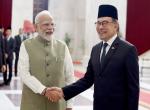The original Article 45 of the Constitution, which forms a part of the Directive Principles of State Policy, read, “The State shall endeavour to provide within a period of ten years from the commencement of this Constitution for free and compulsory education for all children until they complete the age of fourteen years”.
By the Constitution (86th Amendment) Act 2002 a new Article 21-A was introduced after Article 21 as a part of the Fundamental Rights and Article 45 was substituted by a new Article 45. The two Articles read, Article 21A – “The State shall provide free and compulsory education to all children of the age of six to fourteen years in such manner as the State may, by law, determine.". New Article 45 – “The State shall endeavour to provide early childhood care and education for all children until they complete the age of six years". In Article 51A, clause (k) was added which reads, “who is a parent or guardian to provide opportunities for education to his child or, as the case may be, ward between the age of six and fourteen years”. Article 21A, being a part of the Fundamental Rights which are enforceable by law, now makes it the Fundamental Right of a child from the age of six to fourteen years to receive free and compulsory education and the responsibility for providing it rests in the State. Subsequently in the year 2009 by Act No. XXXV of 2009, the Right of Children to Free and Compulsory Education Act 2009, Parliament prescribed by law how this right will be made available to every child in India and what will be the duty of the State in this behalf.
Let us begin with an analysis of what the State must do. Article 21A is now a Fundamental Right and it directs that it is the State which will provide free and compulsory education to all children from the age of six to the age of fourteen years. The law amplifies this provision of the Constitution, but by enacting a law the State cannot shrug off its responsibility to ensure that every child is educated and that this education is free. As per the Schedule to the Right of Children to Free and Compulsory Education Act, 2009 (hereinafter referred to as the Act) the State has to ensure that between Class-I and Class V in a school which has up to sixty students there will be at least two teachers, between sixty-one and ninety students, three teachers, between ninety-one and one hundred twenty students, four teachers, between one hundred twenty-one and two hundred students, five teachers plus one headmaster and above two hundred children the pupil-teacher ratio will not exceed one teacher for forty students. Between 6th and 8th Class it would be mandatory for there to be one teacher for thirty-five students and dedicated faculty in Science, Mathematics, Social Studies, Languages and part time teachers in Art, Education, Health and Physical Education. In the matter of physical infrastructure every school must have an all-weather building with one classroom for every teacher and an office for the head teacher, separate toilets for boys and girls, safe and adequate drinking water, a kitchen for mid-day meals, a playground and perimeter fencing or wall. There is provision for a library, teaching and learning equipment and play and sports equipment. This means that in a school which does not have these facilities government by law is bound to provide them and to do so immediately. The law, therefore, mandates that the Ministry of Human Resource Development at the Centre and the Education Department in the States must make adequate budgetary provision to ensure that within a reasonable time these norms are met and because this is as per provisions of law government can be taken to court for any failure in this behalf.
Chapter III of the Act gives the duties of the appropriate government. Section 6 of the Act says that where a school of the appropriate standard does not exist government shall establish it within three years of the commencement of the Act. This means that by the end of the year 2012 schools of the appropriate standard should be established. The fact is that nothing of the sort has happened, nor is it likely to happen soon in terms of section 7 of the Act. The Central Government is required to prepare the estimates of capital and recurring expenditure for the implementation of the Act, but it is not the Central Government alone which would provide the money. The State Governments will be given grants and subventions by the Central Government and a reference can be made to the Finance Commission for recommending additional funds to be given to the State Governments. Under section 8 the appropriate government is required to provide free and compulsory elementary education to every child, which means that even if the Central Government does not provide adequate funds the States will have to do so from their own resources. This applies to local authorities also. This leaves the question of funding wide open. Some States may provide adequate funds and the schools there will improve. Other States may not be so fortunately placed and the standard of schools would, naturally, be that much poorer. Urban local bodies may and in fact do provide better schools than rural local bodies. Depending on the pattern of funding in a State this unequal situation may continue to prevail.
Chapter II of the Act is important because it is this provision of law which gives a child the right to free and compulsory education in a neighbourhood school. The Act does not define neighbourhood schools and it would be left to the Central Government or State Governments under section 38 (2) (b) to frame Rules to define the area or limits for establishment of a neighbourhood school. In section 2 (n): a school is defined as an establishment owned or controlled by government, an aided school, a school belonging to a specified category and a wholly unaided school. A specified school is a school which is a Kendriya Vidyalaya, a Navodaya Vidyalaya, a Sainik School, or a school notified as such by government. Every school is required to reserve twenty-five percent of seats for admission to Class I for children from the weaker sections and disadvantaged groups in the neighbourhood. An unaided school would be entitled to reimbursement per child admitted upto a maximum of the per child expenditure provided in the budget of a school established by government or by a local authority. In other words, twenty-five percent of the children admitted to public schools (here the British definition of public school applies), that is, unaided schools will not pay the fees of that school and instead government will reimburse the school to the extent that government would have spent per child studying in a government school. Considering the high fees structure of most public schools and other unaided schools, this reimbursement would be a pittance.
The total number of students studying in privately owned, unaided schools in Class I is about 72 lakh. Twenty-five percent of this comes to 18 lakh. The structure of the unaided schools would now change with 54 lakh students being from families which pay the full fee and other costs of the school and 18 lakh children who themselves pay no fees but on whose behalf government reimburses an amount equivalent to the cost of educating that child in Class-I in a government school, which would be much less than the normal fees of the school. Within the same school one would have two categories of students. Category-1 would be the full fee paying children who come from affluent families, well-dressed, probably coming to school in the family car, carrying their own tiffin and having pocket money. Twenty-five percent of the students within the same school would come from relatively poor families, would not be as well-dressed as the fee paying students, would be less familiar with languages such as English and would generally be looked down upon by other children for lack of sophistication. Children from affluent families probably have association with educated people and, therefore, at least superficially are better off in manners and bearing than the children from poor families. This divide which is social could also become a learning divide which would split the school wide open. Is this the purpose of education, to create a caste system or class system within the same school and have a whole group students feeling inferior to the majority of students?
The number of students seeking admission to schools under the Act would be approximately 2.5 crores in Class I. If only 18 lakh students are to go to non-government schools, that would leave government schools to cater for about 2,30,00,000 (two crore thirty lakh) students. Where these children would be accommodated? Obviously, in the nearest government, municipal or panchayat school. Except for a few large urban centres the government and local body schools have a very poor infrastructure and in backward states the infrastructure would put a pig-sty to shame. Most village schools do not have any furniture and the children sit on the ground on a strip of jute matting if they are lucky or on the bare ground if they are unlucky. These students may be even worse placed than category-2 students within a non-government school, whose infrastructure may be marginally better. They would be the third category of school children in Class I. To recall, category-1 would be the fee paying students in non-government schools, category-2 would be students in non-government schools who enter that school under the provisions of section 3 of the Act read with section 12 and category-3 would be students in government schools. Category-1 would look down upon category -2 which, in turn, would look down upon category-3. This is not free and compulsory education -- it is a perpetuation of the worst aspects of the caste system. The Right of Children to Free and Compulsory Education Act, therefore, will become a device for perpetuating and accentuating the caste and class divisions in society.
Another question which arises is why the State has deliberately restricted the right to education up to the age of fourteen, that is, the end of middle school education. Our education system has three phases with Classes I to V being the primary school, Classes VI to VIII being the middle school and Classes IX to XII being the high school and higher secondary school. Education upto Class –VIII does not quality a child for any kind of a job even on attaining majority and it only opens up the door to higher secondary school or to vocational education. Surely a child should be supported till Class-XII, by which time it should have acquired an adequate level of education to become competitive and to enter a college or go directly to the job market. Other countries take children up to the end of high school and the Right of Children to Free and Compulsory Education Act, as also Article 21 A, should extend this right upto the age of eighteen or nineteen so that a child entering the school system at least goes up to the higher secondary level.
Whence comes the right to education? One commonly held belief is that the right emanated from the original Article 45. It can now be argued that it comes from Article 21A. Both thoughts are erroneous because the right to education is contained in the Preamble to the Constitution. The Preamble mandates Justice, social, economic and political and Equality of status and of opportunity which can only come about if there is equity in education and imparting of knowledge. The right to education, therefore, emanates from these two provisions of the Preamble itself. Article 21A confers no additional rights though it does specify within the body of the Constitution itself that there is a fundamental right to education. The government of the day is a creation of Part V, Chapter 1 of the Constitution and Part VI, Part 2 of the Constitution in the case of the Union and the States respectively. It is these Parts of the Constitution which create the Executive or the Government. The duties of the government in the matter of providing education up to the age of fourteen are given in Chapter III of the Act. That being the case what we really need is not a Right to Education Act, but a Duty to Educate Act. That Act should categorically state that it is the duty of the State to educate all children upto the higher secondary level, to ensure that the educational institutions are of a quality where they can impart genuine education and not merely make a sham of promoting literacy. The minimum standard to be achieved should be that of the Navodaya Vidyalayas.
Since 2004 I have been writing to the Prime Minister that government must establish at least ten thousand new Navodaya Vidyalayas so that quality education reaches down into rural India. Obviously what I said made sense because the Prime Minister publicly announced in 2007 that government would establish six thousand new model schools of the Navodaya standard. This would be the right step in fulfilling the duty of government to educate. What happens to this announcement? The Planning Commission and Ministry of Human Resource Development insisted that these schools will be established in the Public-Private Participation (PPP) mode. The plea taken was that government did not have adequate funds.
This is violative of the even somewhat anaemic provisions of section 7 of the Act in the matter of funding and, therefore, is both morally and legally untenable. However, it is definitely indicative of the mindset of a section of government, unfortunately the very section which deals with education. Article 21A was brought on the Statute Book and the Act enacted because there was public pressure and because government thought it could win kudos by these paper transactions, However, the intention to educate was never there because it was never intended to provide adequate funds. The 86th Amendment of the Constitution and the Right of Children to Free and Compulsory Education Act, 2009 are both fraudulent in that the law-makers knew that there was no intention to enforce the right. What can one say about a country whose rulers refuse to acknowledge that the base of civilization, of society, of knowledge, of culture, of higher education and technological achievement is the school? If the level of the school is as miserably poor as that of the average Indian school, what sort of a base or foundation would we have? The superstructure of the education system at present rests on quicksand. God help this country if we do not genuinely decide to not only give the right of education to our children but to actually enforce this right with all the resources at our command.
Published Date: 16th May 2012









Post new comment